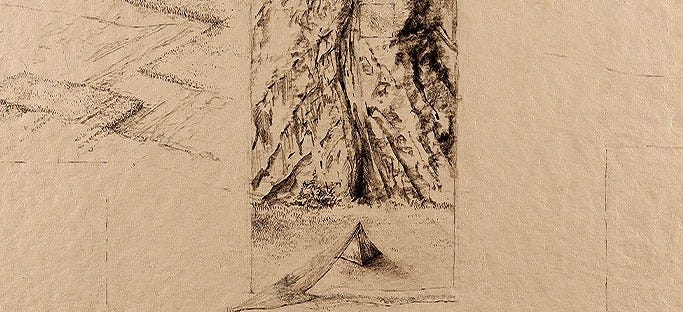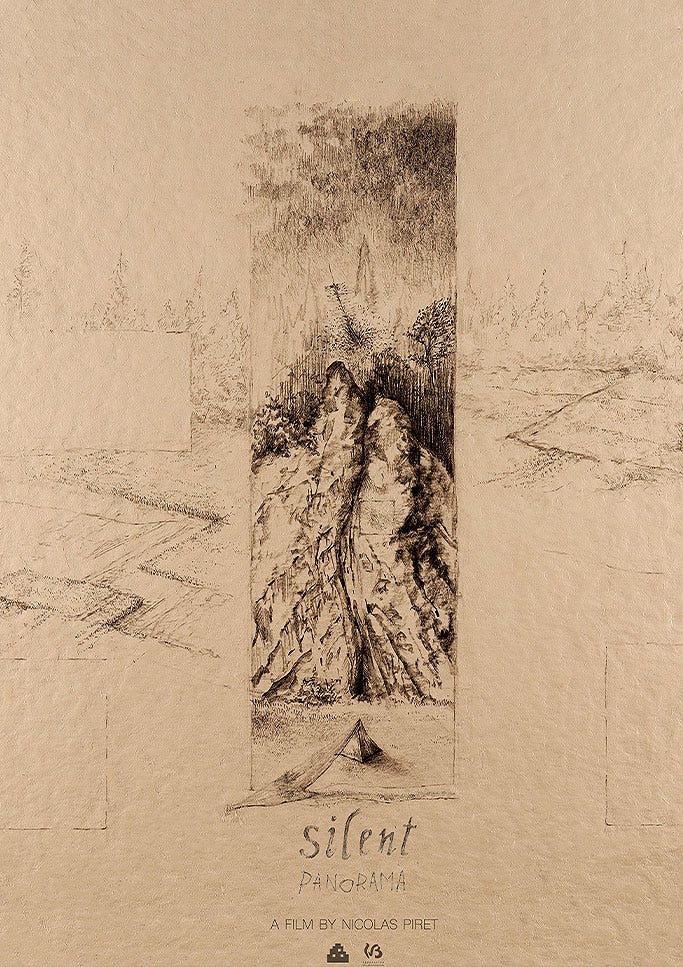"Sound Dictates The Rhythm of The Film And The Flow of Its Narrative": Interview with 'Silent Panorama' Director Nicolas Piret
From King Kong to a walk in the Ardennes, Nicolas Piret takes us behind the scenes of his second short film, an experiment as mush a wonderful piece of animated art.
I discovered Nicolas Piret’s work this year in Annecy, where his latest short Silent Panorama made its French premiere as part of the Perspectives category.
And has been in my mind ever since. The idea of seeing a world unfold on a single sheet of paper is something I find truly mesmerizing, and Silent Panorama is anything but a silent film.
In this short, at the foot of a cliff in the middle of nowhere, two campers, intrigued by the noises outside, cross the deserted landscape, lamp in hand. In pursuit of an unknown creature that could be either real or out of a dream, the two characters unveil a buzzing panorama.
After seeing a second time - on a bigger screen - at Cartoon Business, where it was showcased as an example of Belgian productions to international professionals by Zorobabel, I reached out to Nicolas to dive deeper into the making of this unique film. Below you’ll find the translated version of the interview.
First of all, what would be your very first memory of animation?
Nicolas Piret: Willis O’Brien’s work on King Kong (1933) and his Skull Island, with its luxurious jungle that I love drawing as a child! Going back to that memory, Silent Panorama is kind of reminiscent of this memory. It just lacks the big beasts.
What drove you to write this story through this particular technique?
I originally studied drawing at the Ecole des Beaux-Arts, with a period in comics, before going on to study animation. I've always used animation and video as a means of extending my graphic research. That's why I've thought of this film as a kind of moving picture, where the landscape and backdrops would be revealed slowly on a single sheet of paper.
As with my previous short La bride aka The Dog's Leash, my graduation film released in 2022, this story is a reconstruction of my memories. During a night in a tent in the Belgian Ardennes, my partner and I were awakened by noises outside. Unable to sleep, we set off on a long walk, guided first by certain noises, then by distant lights.
In this film, I wanted to capture each of the elements that we came across, and paint a portrait of a place that, when you take the time to look and listen, can be full of stories.
What were the biggest challenges during production?
As the animation is drawn with pencils on a single sheet of paper using an erasing technique (as you go along, the erased action is redrawn and then erased again to create the movement), I had to be extremely meticulous to avoid certain errors that would have been fatal to the film.
Erasing in the same place can lead to crumbling and tearing of the paper. I had to pay close attention to this, as well as to eraser debris and other marks.
As the whole thing is drawn on an A3-sized sheet of paper, each element is actually tiny, and a small hand trace, inadvertently, can quickly wipe out an entire forest.
For the performance to succeed, numerous animatics were required to orchestrate everything in advance. As each movement left indelible traces, it was impossible to go back and correct elements.
Now that the film has been completed, all I have left is a single drawing containing its traces, traces that only film can now reconstruct.
How has the film evolved between your first script and its final version?
Not a lot actually, but the order of events required a lot of thought and experimentation/animation. These were also drawn on a single sheet of paper, in order to be as prepared as possible.
These were used to reorganize the consequential actions that would take place on screen, so that they could direct the viewer's gaze to the various corners of the screen and make the wandering work.
Sound plays a crucial role in your film, could you elaborate on this specific part of your work?
As with my previous short, sound dictates the rhythm of the film and the flow of its narrative.
Thought of as a kind of score, it was necessary for me to compose the sound effects in advance, right from the animatic phase. Sound acts as much as drawing in the unfolding of the film, often defining things not visible on screen.
Because of its concept based on the spatiality of sound, once the animation was finished, I was joined by Pierre Van Caloen to clean up the sound effects. The film also benefits from the meticulous work of Frédéric Furnelle, who also handled the various mixes.
Here, 5.1 surround sound was essential to really immerse the viewers in nature, so that their gaze would turn in search of every little element interrupting the silence.
Finally, a broader question: what is animation for you as a medium?
Animation is much broader than what is often categorized. Fortunately, over the last few years, the barriers have been breaking down more quickly, and we're beginning to see a thirst for discovery in the public, who are also beginning to see it in a different light.
For my part, I'm looking for an extension of my graphic work in drawing, confronting the fine arts with the animation. To pursue this research, I'm currently working on a new short film with Take Five, which will complete the naturalist trilogy I started with La bride and Silent Panorama.
The film is not yet available on streaming platforms, but you can discover its mysterious trailer here.
In the meantime, I hope you enjoyed this bit. I for myself will definitely go back to Silent Panorama many times, a soothing and beautiful cinematic experience.
Have a great animated weekend,
Kevin







